#Pueblo Indian Pottery
Text
#ndn look#southwest design#native american#indian art work#new mexico art#pueblo pottery#acoma sky city#Pueblo people#abstract art of the southwest#shawn vallo#ndnlook#indian look#shon vio
0 notes
Text
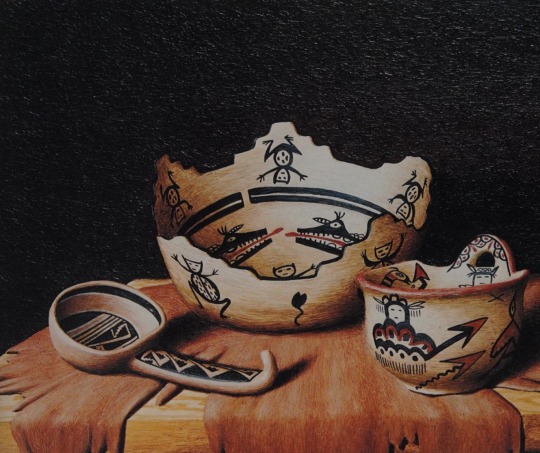
“Three Pueblo Indian vessels showing unusual forms. Left, dipper of Homolovi Polychrome, circa 1325; center, Zuni prayer-meal bowl, circa 1910.
1 note
·
View note
Text
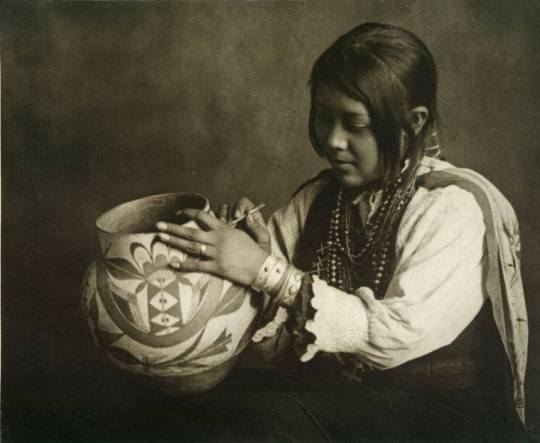






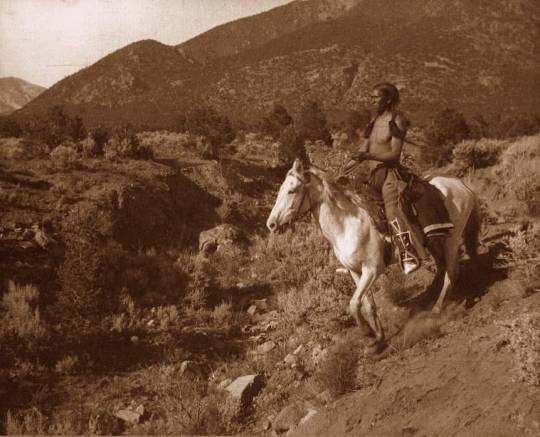




Carl E. Moon (American, 1878 – 1948) learned his craft as an apprentice to a photography studio. Subsequently he moved to Albuquerque, New Mexico, and opened his own studio, where he made pictorial studies of Indians that were living in the region.
In the early 1920's Moon established a studio in Pasadena, California, where he continued to photograph and paint. During the last three decades of this career, the Photographer produced works for Henry E. Huntington, published "Indians of the Southwest", and contributed illustrations for children's books written by his wife, Grace Purdie Moon.
The Pottery Maker, 1910
The Meeting Place, Taos: Border of New Mexico Near Colorado Line, 1908
Arrow Maker. Taos Pueblo, New Mexico. ca. 1904
The Flute Song, Taos Pueblo, New Mexico, 1900
A Taos Pueblo runner, 1914
Up the Acoma trail, Acoma Pueblo, New Mexico, ca. 1904
"The Black Jar", 1900
The Scout, Taos Mountains, New Mexico, 1904
Pedro Begay, Navajo, 1907
Hopi Mirror, Pool near Walpi, Arizona, 1900
Lotta Atsye, the chief’s daughter of the Laguna Pueblo, 1904
Haz-Pah, Navajo, 1914
44 notes
·
View notes
Text
Some Maps
To get a sense of the locations I'll be talking about.
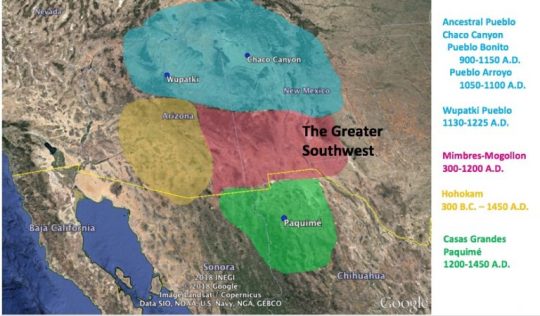
This map from the University of Florida displays the general extent of Southwestern "culture areas" of the past ~2000 years, mapping four major cultural traditions defined by suites of similar architecture and artifacts. It's important to note that, 1000 or 800 or 600 years ago, it's unlikely that people from the marked regions would have considered themselves All The Same People; rather, this is an archaeological designation of material culture similarities that represents likelihood that people were operating from a similar cultural logic.
Here's a different one, by Catherine Gilman and Kathleen Bader:

Is Sinagua its own distinct cultural group, or does it represent the place where the borders and the styles and the logics of Hohokam, Pueblo, Mogollon, and Patayan cultural trends overlapped and intermixed? Should "Salado" be considered a culture in its own right? (In my dissertation I treat the answer as No Not Really!) Should the Trincheras tradition be treated as a distinct cultural group, or a subset of Hohokam, and where is that boundary? How big was the Casas Grandes sphere of influence?
These give a good sense of the distributions of various pottery traditions, the spheres of cultural influence, and the difficulty of defining cultural boundaries of the past.
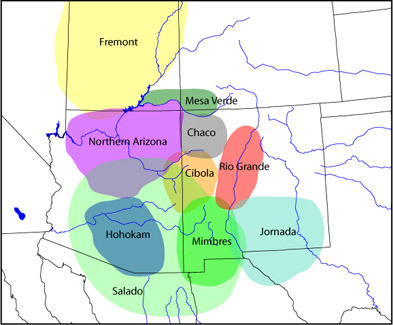
This map by Matthew Peeples shows ceramic typological regions - that is, areas that were making similar ceramic types, with similar clays, technologies, and decorative methods.
And, to put it in perspective, the modern locations of Pueblos, tribal nations, Indian Communities, and other reservations:


It can very quickly get difficult to picture where everything is in relation to each other, so I hope these maps will serve as a useful reference!
33 notes
·
View notes
Text
Fake Indian art still a major problem despite federal responsibilities
Criminal pleas surface amid vague ‘Indigenous’ claims
Tuesday, March 14, 2023
By Acee Agoyo, Indianz.Com
Efforts to strengthen the Indian Arts and Crafts Act are gaining new steam as government authorities try to enforce a law aimed at addressing fraud and exploitation of Native cultures and ways of life. On Monday, the Democratic chairman of the Senate Committee on Indian Affairs unveiled a discussion draft bill called the Amendments to Respect Traditional Indigenous Skill and Talent Act of 2023. Also known as the ARTIST Act [PDF], the proposed legislation seeks to protect the arts, crafts, goods and other creative works that American Indian, Alaska Native and Native Hawaiian people have produced since time immemorial.
“The ARTIST Act would update the Indian Arts and Crafts Act to support creative economies and strengthen enforcement of current law and protections against counterfeit competition for Native artists and their works,” the committee said in a news release on behalf of Sen. Brian Schatz (D-Hawaii), the chair of the legislative panel. “This discussion draft reflects direct stakeholder input as well as years of committee oversight and broad commitment to the protection of Native cultural patrimony and revitalization of Indigenous languages,” the release continued.
As enacted in 1990, the Indian Arts and Crafts Act makes it a crime to market, sell or promote an item as “Indian” unless it was created by a citizen of a state or federally recognized tribe or by an artisan certified by a tribe. The law was written to prevent the historical and ongoing misrepresentation of Native arts by non-Native entities. Yet Native artists and their advocates have long complained about the lack of enforcement as fakes and frauds have continued to flood the market and undermine an important source of income in Native communities across the United States.
It’s an issue that Secretary Deb Haaland, who is the first Native person to lead the Department of the Interior, has recognized as a major problem. “Native art is a critical part in telling the story of this country and can only be told by Native artists,” Haaland said in a video message after making history as the first Native person in a presidential cabinet. “Buying authentic pottery, jewelry, mixed-media creations, paintings and other art from Native American artists helps support tribal economies.” “Unfortunately forgery and copies hinder the positive economic opportunities available to Native artists and their families,” said Haaland, who is a citizen of the Pueblo of Laguna.
youtube
The law was updated in 2000 and in 2010 to strengthen enforcement. But as fraudulent works continue to be sold in some of the largest art markets in the U.S., the ARTIST Act builds on prior efforts by broadly expanding the ways in which federal officers can investigate suspected violations. Federal officers, for instance, would be authorized to make arrests, engage in searches and even conduct seizures for suspected violations of the Indian Arts and Crafts Act.
They would also be able to inspect shipments coming into the U.S. to ensure compliance with the law, according to provisions of the draft. And for the first time, Native Hawaiians would gain protections for their creative works. The ARTIST Act modifies existing definitions in federal law to ensure that the original inhabitants of Hawaii aren’t left out of enforcement efforts that are available to American Indian and Alaska Native artisans.
To help pay for these enforcement measures, the ARTIST Act authorizes ways in which people suspected of violating the law can have their property forfeited and be required to shoulder the costs of investigations through fines and penalties. A new Indian Arts and Crafts Forfeiture Fund would be established to assist the work of the Department of the Interior.
The draft discussion bill also requires visible and permanent labeling of items that come into the U.S. from Canada or Mexico. Anything that could “possibly be mistaken for, arts and crafts made by Native Americans” must be “indelibly marked with the country of origin,” according to provisions of the the ARTIST Act.
Finally, the ARTIST Act would require trainings of federal law enforcement officers, not only on the Indian Arts and Crafts Act but on the recently-enacted Safeguard Tribal Objects of Patrimony Act, also known as the STOP Act. The latter law makes it a crime to export tribal cultural property, another issue that has threatened Native cultures and ways of life. “For too long, the export and sale of sacred and culturally significant items from Native peoples in Hawaiʻi, Alaska, and across Indian Country has deprived these communities of their own history and heritage,” Schatz said after the measure was passed and signed into law during the prior session of Congress. “Our bill will help stop the black market trafficking of these items and bring them home.”
Just this month alone, federal authorities announced the resolution of three cases in which the Indian Arts and Crafts Act was violated. In all three instances, non-Natives created and sold fraudulent art by misrepresenting, falsifying and lying about their non-existent tribal backgrounds. In Washington, 52-year-old Lewis Anthony Rath and 67-year-old Jerry Chris Van Dyke, also known as Jerry Witten, pleaded guilty on March 1 to breaking the law.
Both men admitted that they sold fake “Indian” goods in the historic Pike Place Market in Seattle, one of the most heavily trafficked tourist areas in the city. “When non-Native artists falsely claim Indian heritage, they can take sales away from true Indian artists working to support themselves with skills and techniques handed down for generations,” Nick Brown, the U.S. Attorney for the Western District of Washington, said in a news release. “Stores and galleries need to partner with artists to ensure those artisans and craftsmen advertised as Indian Artists truly have tribal status,” Brown added, offering advice to businesses to ensure they comply with the law.
Rath falsely claimed to belong to the San Carlos Apache Tribe — while producing items that mimicked the Pacific Northwest tribal cultures that are hundreds of miles from his supposed Native homeland in Arizona. According to federal authorities, the goods were sold at the Raven’s Nest Treasure and the Ye Olde Curiosity Shop, both of which represented to customers that Rath was Native. And when agents from the U.S. Fish and Wildlife Service, which is part of the Department of the Interior, searched Rath’s home and studio, they found feathers from protected birds — including ones from golden eagles. He pleaded guilty to unlawful possession of these items in addition to violating the Indian Arts and Crafts Act.
Meanwhile, Van Dyke falsely claimed to be from the Nez Perce Tribe and was selling goods that he claimed were of Alaska Native origin — again far away from his supposed tribal background in Idaho. According to federal authorities, he produced the items using materials that were supplied to him by the non-Native owner of a gallery in Pike Place.
“Van Dyke had worked with the gallery for more than ten years, with the gallery owner providing him with woolly mammoth ivory, antlers, animal bones and fossilized walrus ivory to make the pendants that it sold,” the U.S. Attorney’s Office for the Western District of Washington said in the March 1 news release. A day later in Texas, the U.S. Attorney for the Western District announced the sentencing of Kevin Charles Kowalis, 60, for violating the law. According to federal authorities, he falsely marketed and sold jewelry online that he claimed were of “Zuni” and “Navajo” origin even though he does not belong to either tribal nation.
“Fraud can come in many forms but always carries the intent to deceive a victim,” U.S. Attorney Jaime Esparza of the Western District of Texas said in a news release. “Offenders like this defendant victimize both our cherished Native American community and consumers who believe they’re collecting authentic pieces of Native American culture. We will not stand idle while someone takes advantage of our citizens and our federal resources.” Kowalis will serve five years probation for his crime and was ordered to forfeit his inventory, pay a special assessment and pay restitution to a victimized artist from the Pueblo of Zuni.
The total amount appears to be relatively low — less than $1,500, according to court records. No fines were ordered due to his “inability to pay,” the criminal judgment reads. “This sentencing is important in the fight to end this type of fraud,” said Assistant Director Edward J. Grace of the U.S Fish and Wildlife Service’s Office of Law Enforcement. “Our dedicated team of special agents works on behalf of the Department of the Interior and the Indian Arts and Crafts Board to protect American Indian and Alaska Native artists and the consumers who purchase authentic Native American art and craftwork.”
Over in Washington, Rath and Van Dyke are due to be sentenced on May 17. As part of a plea agreement, federal prosecutors said they won’t seek prison time for Van Dyke. Rath did not obtain any promises regarding sentencing in his plea agreement. A federal judge, though, will make the final determination on punishments for both individuals.
“The Indian Arts and Crafts Board (IACB) is very pleased that Jerry Chris Van Dyke and Anthony Rath have been brought to justice for their roles in selling fake Indian artwork in violation of the Indian Arts and Crafts Act,” said Director Meridith Stanton, the leader of the IACB, which is part of the Department of the Interior. “Cases like these are critical to preserving the integrity and viability of authentic Native American art and craftwork in general, as well as preserving the rich cultural heritage of the Nez Perce Tribe and the San Carlos Apache Tribe and the economic livelihoods of their artists and craftspeople,” said Stanton.
The IACB helps look into potential violations of the Indian Arts and Crafts Act, offering examples of possible wrongdoing. But the board’s website notes that items that are marketed or portrayed as “Native American style” or “Native American inspired” can be sold without violating the law — so long as there is “qualified labeling” available to the consumer.
The draft discussion of the ARTIST Act maintains the legality of these categories of “Native American-style jewelry” and “Native American-style arts and crafts” but requires that such items be “indelibly marked” or labeled in a “permanent” fashion, to ensure the consumer is aware that they are not produced by an American Indian, Alaska Native or Native Hawaiian artist.
And while the title of the ARTIST Act contains the word “Indigenous,” the proposed bill does not contain any definitions of a term that has become increasingly used by people who are creating, marketing and selling art that they claim is Native in origin.
An example just emerged in New York, where a self-described activist opened an exhibit in February that appropriates numerous elements of Native culture even after admitting to Indianz.Com that they do not belong to any tribal community. The exhibition, located at a small gallery in the Upper East Side of New York City, notably incorporates the red imagery that Native women developed and brought to prominence to raise awareness to their missing and murdered sisters and relatives. It also includes a visual representation of a Native quilted blanket — albeit with the word “PRETENDIAN” stitched into it.
The Soul of Nations Foundation has prominently marketed the installation as “Indigenous” in origin, a designation that has prompted some Native people to consider reporting it to the Indian Arts and Crafts Board for possible violations of the Indian Artist and Crafts Act. In fact, the non-profit’s executive director and founding member, Ernest Hill, contacted Indianz.Com numerous times in advance of the opening on February 24, soliciting news coverage for an individual who removed all references to their supposed tribal affiliation over a year ago.
Yet Hill, whose parents served as religious missionaries to the Navajo Nation and to other reservations, has since refused to answer questions about the exhibition — including inquiries about the artist’s supposed tribal background.
Materials that Soul of Nations produced for the installation claim it is directed to “Indian Country” but the organization has repeatedly refused to respond to inquiries about the use of the designation in connection with someone who admitted they lack ties to any tribal community. Hill and Soul of Nations also have refused to clarify the source of funding for the project.
In press materials, they proudly assert that the installation has received “support” from the Department of State. On social media, Hill and Soul of Nations gave a different story. In response to a prominent Native environmental leader who has repeatedly attempted to hold the self-described activist accountable for the false claims of tribal belonging, they claimed that “no outside funding was provided for this exhibition.”
When asked to explain the discrepancy between the press materials and the social media post regarding their claim of receiving federal support, Hill and the Soul of Nations refused to respond. The organization started blocking Native users on social media and began restricting interactions on one of its accounts after questions were raised about the installation. The Soul of Nations website, incidentally, includes a prominent reference to the “Senate Committee on Indian Affairs” on a page that has been used to solicit monetary donations. The Department of State is also listed in the same section of the site.
Since the opening of the installation last month, the self-described “Indigenous” individual has posted on social media about being on “Day 371” of a “cancel” and a ‘call out” that has purportedly kept them “jobless.” The number of days is counted from the February 25, 2022, story on Indianz.Com that reported on their their non-existent tribal affiliations. The next post on the private account was about the installation, which opened to the public a year following publication of the story. The user has since deleted hundreds of posts about their supposed tribal background from the account, whose name is a variation of an anti-LGBTQ slur.
The Senate Committee on Indian Affairs is accepting comments about the Amendments to Respect Traditional Indigenous Skill and Talent (ARTIST) Act of 2023 until April 14. Comments can be sent to [email protected].
#art#native american#indigenous#indigenous artists#native news#scams#frauds#us politics#us government#indian law#native art#indigenous art#native artists#current events#Youtube
69 notes
·
View notes
Text
“Wherever Europeans and native peoples came into contact, Indian women were fundamental links in the chain of mutual exchanges, mutual suspicions, and mutual understandings that bound their two peoples together. …For native women in the Spanish colonies of the Southwest, cultural translation might mean performing one’s traditional duties--tasks which typically included childbearing and childrearing; the gathering, serving, and preparing of goods; the weaving of blankets and clothing; and the production of pottery--with new materials and for new ends.
…Native women in the American Southwest also engaged--or were forced to engage--in another, more literal kind of cultural blending. Like Pocahontas, La Malinche, and Sacajawea, many of them became involved in sexual relationships with European men. All manner of Spanish males, including soldiers, settlers, governors, and even priests, made Pueblo women their sexual partners--often against the women’s wills. The rape of native women was a virtual weapon of war for many Europeans trying to bring new territories under their absolute control.
…Faced with this most violent kind of cultural blending, native women acted not as “translators,” but as resistors of foreign domination. Amerindian women often spearheaded the opposition to their sexual colonization. In Old California, for example, they led attacks on missions they deemed responsible for assaults against them. Toypurina, a 24-year-old medicine woman from a settlement near San Gabriel, led the combined forces of six or eight Indian villages in a 1785 attack on the mission there.
…Where their economic roles were concerned, native women were essential to forging a kind of rapprochement between Indian and European ways. In New France, the chief context for this blending of tradition and innovation was the fur trade. …French traders counted on the cooperation of village women who, with seeming enthusiasm, consumed European goods and helped to prepare furs to trade for those goods.”
- Jane Kamensky, “A Meeting of Many Worlds” in The Colonial Mosaic: American Women, 1600-1760
13 notes
·
View notes
Photo




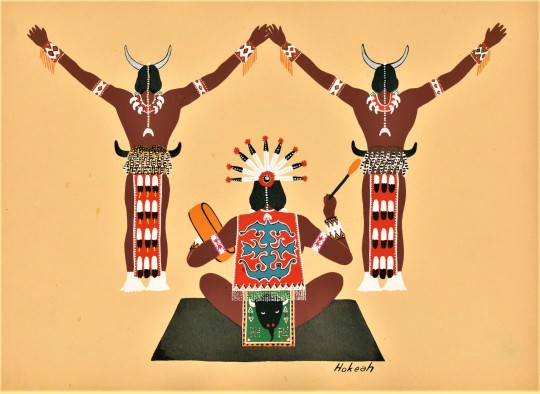

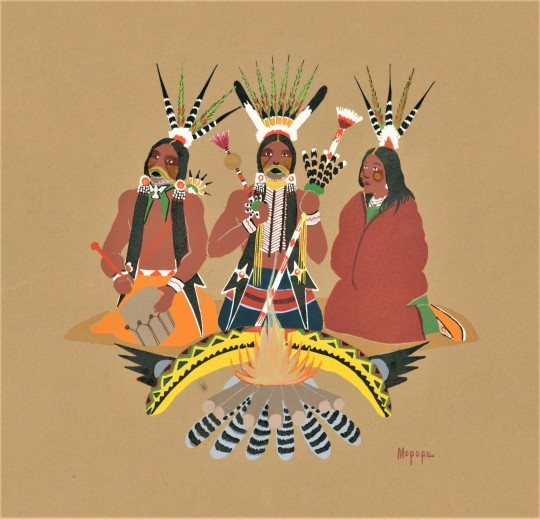
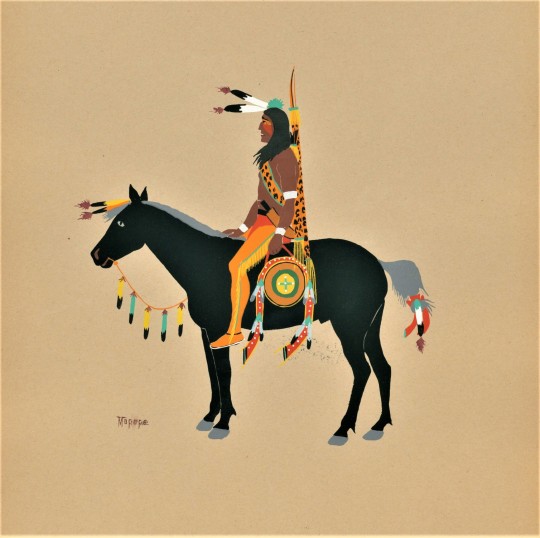
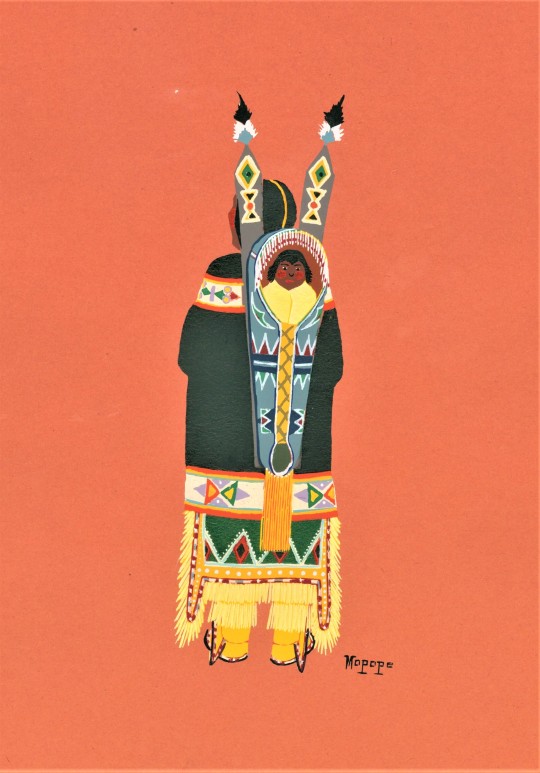
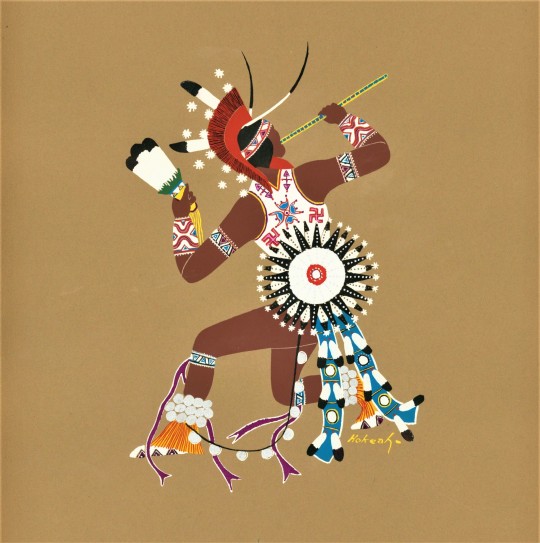
Decorative Sunday
The Nice, France-based decorative arts publisher C. Szwedzicki produced six titles on Native American Art. We’ve already presented their 2-volume portfolio Pueblo Indian Pottery, published from 1933-1936. This week we present some plates from the first of the six titles, Kiowa Indian Art, with images from the collection of Swedish-born American painter and Native American art curator Oscar Brousse Jacobson, published in 1929 in an edition of 750 copies signed by the publisher. The portfolio includes 30 color plates reproducing the paintings of the so-called Kiowa Six: Spencer Asah, James Auchiah, Jack Hokeah, Stephen Mopope, Monroe Tsatoke and Lois Smoky. The images shown here are by Asah, Hokeah, Mopope, and Smoky. Click on the images to see the attributions.
Oscar Jacobson was director of the University of Oklahoma's art department and established a special program at the school in 1926 for these promising Kiowa artists. They were provided with studio space, painting instruction, and choice exhibition venues, including the 1928 First International Art Exposition in Prague where they received international acclaim. This portfolio was produced soon after. The work of the Kiowa Six are considered significant in the development of Native American painting by bridging the era of Ledger Art to flat-style Southern Plains painting. Of the six, the work of Lois Smoky is the rarest and the most collectable as she left the program in 1927 and did not continue painting, although she later became noted as an accomplished beadworker.
View more posts on works published by C. Szwedzicki.
View other Decorative Sunday posts.
#Decorative Sunday#decorative arts#decorative plates#C. Szwedzicki#Kiowa Indian Art#Kiowa artists#Kiowa Six#Spencer Asah#James Auchiah#Jack Hokeah#Stephen Mopope#Monroe Tsatoke#Lois Smoky#Oscar Brousse Jacobson#Oscar Jacobson#Native Americans#Native American art#Native American artists
140 notes
·
View notes
Text
Traditional Water Drums

Water drums are a category of membranophone characterized by the filling of the drum chamber with some water to create a unique resonant sound. The presence of the water within gives the sound far greater carrying power than a dry drum possesses. At close range, the tone of the water drum is often a dull thud, but when properly tuned by an experienced drummer it has a resonance that can be heard for miles. No drum can be heard so far; it is on record that water drums have been heard eight to ten miles over a lake. This capacity to be heard distinctly at a distance, coupled with a peculiar tone quality, gives the water drum a very unique voice.
Water drums are used all over the world, including African music and American Indian music, and are made of various materials, with a membrane stretched over a hard body such as a metal, clay or wood. The Native American Church uses a black iron kettle with three tripod legs. The leather drum head is soaked in water before being stretched over the kettle. Clay pot drums were common among many eastern and southern tribes in the ancient days, those of the South using a semicircular-shaped bowl with legs. The pottery water drum of the Pueblo Indians is a vase-shaped pot with a flared out top. Pueblo water drums vary in size from small pots holding a gallon of water up to huge ones measuring thirty or more inches in diameter. These are filled about one-fourth full of water and the wet hide is tied over the top. When not in use the tanned drumhead and rawhide thong for tying it are kept inside the pot.
Wooden water drums are the traditional percussion instrument for the Native American Anishinaabe (Ojibwe), Ottawa, Potawatomi, Huron and Iroquois peoples. The Eastern Woodland tribes made far greater use of water drums than any other Native peoples, and attached a greater significance to them. To the Anishinaabe and their many neighboring tribes, the water drum is a true medicine drum of great power, the sacred drum of the Midewiwin or Grand Medicine Society, which is at the core of Anishinaabe religion. Water is synonymous with life, hence it adds great potency to the water drum. Its sacred sound is regarded as one of the most effective ways of establishing connections with the spirit realm, since it travels through space, permeates visual and physical barriers, and conveys information from the unseen world. It is widely used today in traditional Longhouse social dances and ceremonies.
Wooden water drums are made either by hollowing out a solid section of a small soft wood log, or assembled using cedar slats and banded much like an old keg. The drum is filled about one-fourth full of water and a wet leather hide is stretched over the top. For detailed instructions on crafting, tuning and playing water drums, download the free eBook, How to Make Drums, Tomtoms, and Rattles by Bernard S. Mason. This classic 1938 edition is now a free public domain eBook.
13 notes
·
View notes
Text
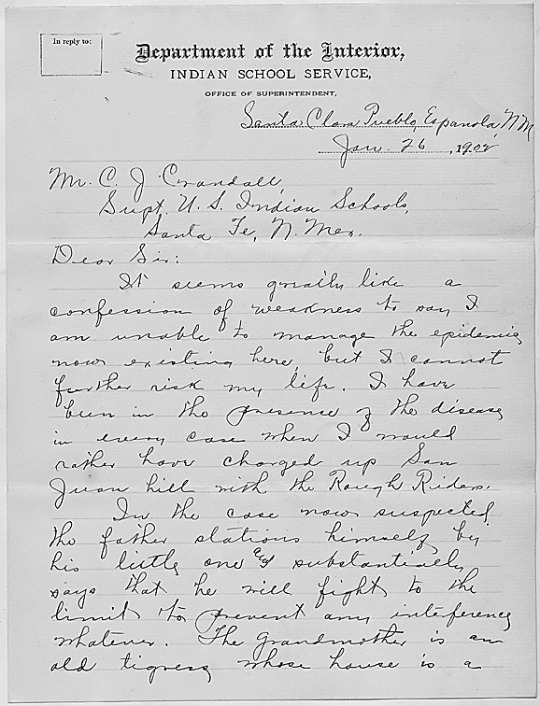
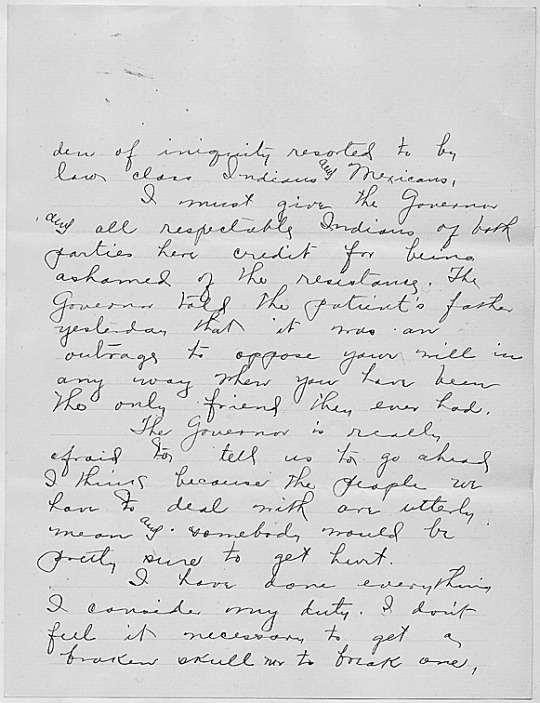
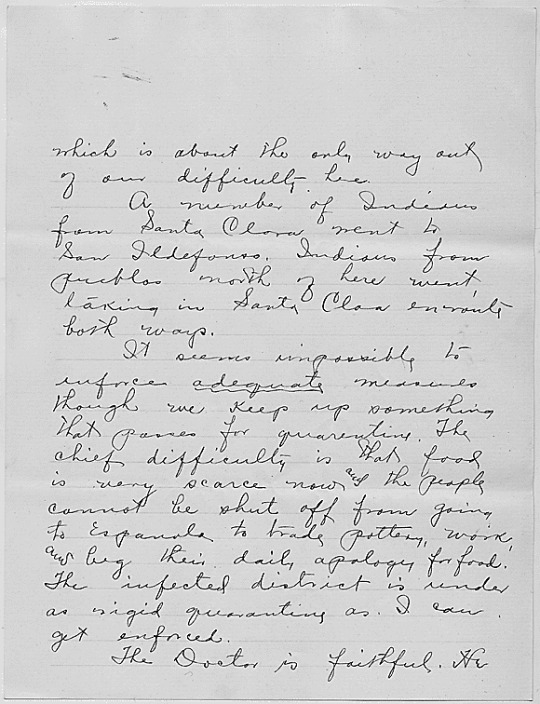

“In the case now suspected the father stations himself by his little one and substantially says that he will fight to the limit to prevent any interference whatever.”
Letter re. diphtheria outbreak at Santa Clara Day School, 1/26/1903.
Record Group 75: Records of the Bureau of Indian Affairs
Series: Letters Received from Day School Teacher Clara D. True
Transcription:
In reply to:
Department of the Interior,
INDIAN SCHOOL SERVICE,
OFFICE OF SUPERINTENDENT.
Santa Clara Pueblo, Espanola, NM
Jan. 26 1902
Mr. C. J Crandall
Supt. U.S. Indian Schools,
Santa Fe, N. Mex.
Dear Sir:
It seems greatly like a confession of weakness to say I am unable to manage the epidemic now existing here, but I cannot further risk my life. I have been in the presence of the disease in every case when I would rather have charged up San Juan hill with the Rough Riders.
In the case now suspected the father stations himself by his little one and substantially says that he will fight to the limit to prevent any interference whatever. The grandmother is an old tigress whose house is a
[page 2]
den of iniquity resorted to by law class Indians and Mexicans.
I must give the Governor and all respectable Indians of both parties here credit for being ashamed of the resistance. The Governor told the patient's father yesterday that it was an outrage to oppose your will in any way when you have been the only friend they ever had.
The Governor is really afraid to tell us to go ahead I think because the people we have to deal with are utterly mean and somebody would be pretty sure to get hurt.
I have done everything I consider my duty. I don't feel it necessary to get a broken skull nor to break one,
[page 3]
which is about the only way out of our difficulty here.
A number of Indians from Santa Clara went to San Ildefonso. Indians from pueblos north of here went taking in Santa Clara en route both ways.
It seems impossible to enforce [underlined] adequate [/underlined] measures though we keep up something that passes for quarentine. The chief difficulty is that food is very scarce now and the people cannot be shut off from going to Espanola to trade pottery, work, and lug their daily apology for good. The infected district is under a rigid quarantine as I can get enforced.
The Doctor is faithful. He
[page 4]
is nearly worn out, however, with Diphtheria everywhere. It appears to be universal in this valley, in the virulent form.
It is more than likely that I have blundered in this case as I am a new hand at this sort of thing. I am ready to take whatever of blame that is due me uncomplainingly as I guess I have bungled someway. If there is anything that I failed to do, it was the result of ignorance. Very respectfully,
Clara D. True
#archivesgov#January 26#1903#1900s#diphtheria#disease#Native American history#American Indian history#Indigenous American history#Pueblo#Indian schools
20 notes
·
View notes
Text


#Nixon50 #OTD 1/31/1974 President and Mrs. Nixon viewed a display of Pueblo pottery in the White House State Dining Room. First Lady Pat Nixon is seen here with Kewa (formerly Santo Domingo) Pueblo pottery artist Santana Melchor and her daughter Crucita. Santana Melchor is considered one of the greatest Pueblo pottery artists and was instrumental in keeping traditional methods of the craft alive. Crucita Melchor received a Lifetime Achievement Award from the Southwestern Association for Indian Arts in 1993. (Images: WHPO-E2154-11 & 2155-20A)
1 note
·
View note
Text
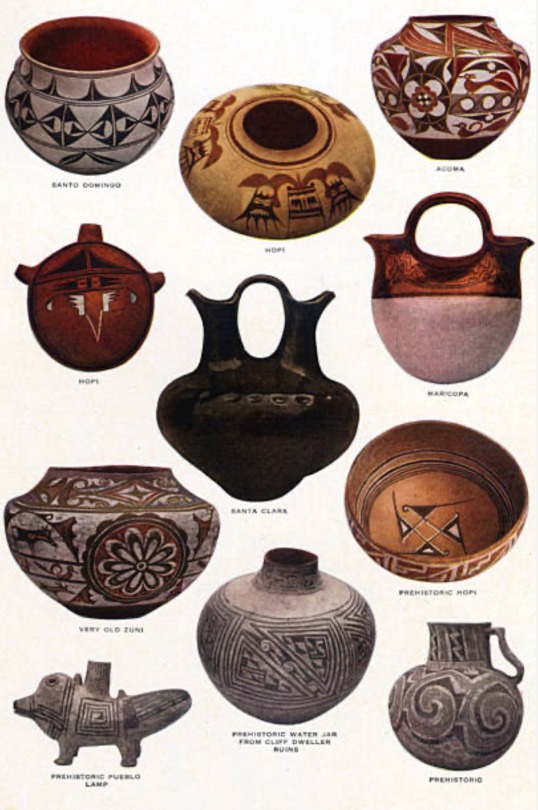
“Native American clay pottery, hand - made by the Pueblo People of New Mexico and Arizona. Selection of different vessels, pots. Pueblo Indian. American Indians. Santo domingo, hopi, acoma, santa clara, maricopa, very old zuni, prehistoric hopi, prehistoric pueblo lamp, prehistoric water jar from cliff dweller ruins.”
Photo by: Culture Club
13 notes
·
View notes
Text

Original Caption: Indians of Santa Clara Pueblo,
New Mexico, making pottery. C. 1900
22 notes
·
View notes
Text
youtube
Maria Montoya Martinez and her son, Popovi Da demonstrate how Pueblo Indian Pottery is made using traditional methods. Filmed in San Ildefonso Pueblo, New Mexico.
3 notes
·
View notes
Text

Ancestral Pueblo mug, c. 1200 AD.
Discovered at Cliff Palace, Mesa Verde, Colorado.
The Ancestral Pueblo Indians perfected a distinctive style of black-on-white pottery such as this mug.
Source of photo: website of the National Museum of the Native American (link here).
3 notes
·
View notes
Text
for this day, here are some indigenous websites/shops to check out:
^^ they have a lot of nice kitchen and home ware
^^ this one has some really beautiful art and tote bags!
3 notes
·
View notes
Text
Climate of New Mexico
New Mexico, often referred to as the Land of Enchantment, is characterized by diverse geography, rich cultural heritage, and a unique climate. Here's an overview:
Geography:
New Mexico is situated in the southwestern region of the United States and shares borders with Texas, Oklahoma, Colorado, Arizona, and Mexico.
The state boasts a diverse landscape that includes deserts, high plains, mountains, and forests.
The Rocky Mountains, including the Sangre de Cristo Range and the San Juan Mountains, run through the northern part of the state, while the southern part is dominated by the Chihuahuan Desert.
See more: https://weatherusa.app/zip-code/weather-87501
https://weatherusa.app/zip-code/weather-87419
Climate:
New Mexico experiences a wide range of climates due to its varied geography, but it is generally categorized as having a semi-arid to arid climate.
Summers tend to be hot and dry, especially in the desert regions, with temperatures often exceeding 90°F (32°C) and occasionally reaching over 100°F (38°C).
Winters can be cold, particularly in the northern mountainous areas, where snowfall is common. However, the desert regions experience milder winters with occasional snowfall.
The state receives relatively low precipitation, with most of it occurring during the summer monsoon season, typically from July to September.
New Mexico is known for its clear skies and abundant sunshine, making it a popular destination for outdoor activities such as hiking, skiing, and stargazing.
See more: https://weatherusa.app/zip-code/weather-87327
https://weatherusa.app/zip-code/weather-87326

Culture:
New Mexico has a rich cultural heritage influenced by Native American, Hispanic, and Anglo traditions.
The state is home to numerous Native American tribes, including the Navajo, Apache, and Pueblo peoples, each with their own distinct languages, customs, and art forms.
Spanish explorers and settlers arrived in the region in the 16th century, leaving a lasting legacy on the culture and architecture of New Mexico. Many towns and cities feature Spanish colonial-style buildings and churches.
New Mexico's arts scene is vibrant, with a strong tradition of pottery, weaving, painting, and sculpture. The state is also known for its annual cultural events, including the Albuquerque International Balloon Fiesta and the Santa Fe Indian Market.
See more: https://weatherusa.app/zip-code/weather-87321
https://weatherusa.app/zip-code/weather-87198
https://weatherusa.app/zip-code/weather-87174
https://weatherusa.app/zip-code/weather-87165
Overall, New Mexico offers a unique blend of natural beauty, cultural diversity, and outdoor adventure, making it a captivating destination for visitors and residents alike.
The best time to visit New Mexico is in the fall season from September to November. During this time, temperatures are comfortable, ranging from 65°F (18.3°C) to 85°F (29.4°C), with pleasant weather both during the day and at night. Fall is less susceptible to storms compared to spring and offers many festivals. Spring has similar temperatures but with more potential for storms, while summer is hot with temperatures often exceeding 100°F (37.8°C), making it less ideal for outdoor activities.
The worst time to visit New Mexico is during the winter from December to February. Temperatures drop below freezing in many areas, and heavy snowfall occurs at high altitudes, with frost common even at lower elevations. Winter days may require sunscreen due to the intense sun, but temperatures drop rapidly after sunset. Despite the cold, skiing enthusiasts can enjoy excellent conditions in the Sangre de Cristo Mountains.
In spring, temperatures are reminiscent of fall, but there's a potential for more storms. Warm days contrast with comfortable nights, attracting tourists as the state transitions from winter to summer. Summer brings intense heat, especially in areas below 1500 meters, with daytime temperatures often exceeding 100°F (37.8°C). Rainfall is highest during the summer months, averaging around 14" (356mm) statewide.
See Weather Forecast for New Mexico today: https://weatherusa.app/new-mexico
https://weatherusa.app/zip-code/weather-87052
https://weatherusa.app/zip-code/weather-87105
Autumn offers agreeable temperatures ranging from 65°F (18.3°C) to 85°F (29.4°C), with clear nights ideal for stargazing. The state's diverse topography means different regions experience varying temperatures, with higher elevations starting to cool as winter approaches. Winter days remain sunny and warm, but temperatures drop rapidly after sunset, often below freezing. Snowfall is common, especially in the northern and central regions, while the southern region remains relatively warmer with less snowfall.
0 notes